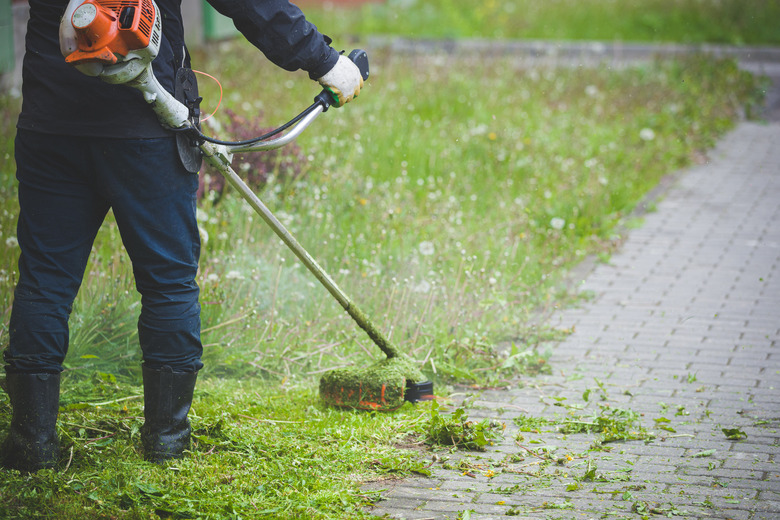How To Tell If The Fuel Filter Is Clogged On A 2-Cycle Weed Trimmer
We may receive a commission on purchases made from links.
Both two-stroke and four-stroke string trimmers have fuel filters. The filter is there to keep debris out of the carburetor, and when it gets clogged, it's because it's doing its job. However, a clogged fuel filter won't allow gas to flow freely into the carburetor, and the engine, starved of fuel, will sputter and die if it starts at all. Both two-stroke and four-stroke engines display the same symptoms.
A two-stroke trimmer engine can be hard to start or can run erratically for a number of other reasons, but because a fuel filter is so inexpensive, replacing it is one of the best places to start the diagnosis. For this reason, professional landscapers who use their trimmers daily usually have to keep a few extra filters on hand. If replacing the fuel filter doesn't improve the trimmer's performance, you know it's time to look for other problems.
Location and Function of the Fuel Filter
Location and Function of the Fuel Filter
The fuel filter is right inside the gas tank. It's usually oblong, about an inch or two in length, and covered with a fine screen or fabric, and it's pushed onto the end of the fuel line, which allows gas to flow from the tank to the carburetor. You can't physically inspect it without removing it from the gas tank, and even then, it's difficult to tell if it's clogged because much of the debris that clogs it is transparent.
The debris is usually residue from old gas or gas that hasn't been properly stabilized, and if it reaches the carburetor, it will gum up the delicate moving parts and make it necessary to clean or rebuild the carburetor. The fuel filter essentially works like a piece of cheesecloth that you stretch over the mouth of a jar before pouring in jelly that you've just cooked on the stove. Eventually, enough impurities collect on the cheesecloth to stop the flow of jelly into the jar, and you have to replace it. You have to periodically replace the fuel filter for the same reason.
How a Clogged Filter Affects Performance
How a Clogged Filter Affects Performance
Just as clogged cheesecloth won't allow any more jelly to enter the jar, a clogged fuel filter reduces or stops the flow of gas to the carburetor. When the carburetor can't get fuel, it has nothing to spray into the combustion chamber, and the little explosions that keep the engine running become less frequent or stop altogether. The person using the string trimmer notices the trimmer sputtering, running erratically, and eventually stopping. When the trimmer stops, it usually won't start again.
Besides fuel, the little explosions in the combustion chamber also need air for combustion and a spark to ignite them, so the tool may sputter and run erratically if the air filter is dirty or the spark plug needs to be replaced. The spark arrestor, which is a small screen behind the muffler to catch sparks and prevent them from flying around and causing fires, can also cause sputtering when it's clogged because it doesn't allow combustion gases to escape. You can usually clean it with a wire brush.
How to Replace a Fuel Filter
How to Replace a Fuel Filter
You could conceivably clean your two-stroke fuel filter by immersing it in a strong solvent, such as lacquer thinner, to dissolve the gums clogging it, but it's easier to replace it. Fuel filters are inexpensive and readily available. You can usually find one at any hardware store that stocks the brand of trimmer you're using.
To replace a fuel filter, you need a piece of wire that you can bend at one end to make a hook. Open the gas tank, insert the wire, and hook it around the fuel hose, which you'll see lying on the bottom of the tank. Gently pull out the hose until the filter, which is attached to one end, comes out. Pull the old filter off the end of the hose and push on the new one — no clamp is needed. When the new filter is secure, drop it back into the tank and push in the hose, being careful not to kink it in the process.
